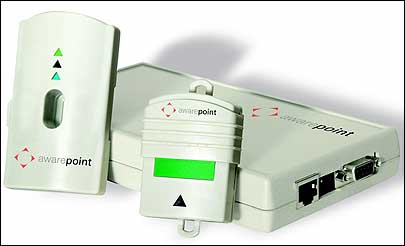Walter Reed Army Medical Center, one of the largest medical treatment facilities within the U.S. Department of Defense, is adopting a real-time location system (RTLS) that uses ZigBee-based RFID tags. The hospital plans to utilize the system to track 4,000 pieces of equipment, according to Awarepoint, a San Diego provider of RTLS technology designed for tracking assets in health-care facilities.
The Washington, D.C., hospital expects the Awarepoint system will help its nursing staff more quickly and easily locate equipment, allowing more time for direct patient care and reducing wait times for patients requiring transport throughout the 1.1-million-square-foot facility. Administrators will use the system to generate automated messages when an instrument is due for periodic maintenance, and to locate equipment in the event of a recall.
Awarepoint has signed a four-year contract to provide its services to Walter Reed, says Awarepoint’s CEO, Jason Howe. Those services include the installation, management and maintenance of the system. The company plans to begin installing the system sometime after Thanksgiving, and hopes to have the installation completed before mid-December.
To locate assets, the company employs active RFID tags operating at 2.48 GHz. The tags transmit their unique IDs over the 802.15.4 (ZigBee) communications protocol, to small receivers (access points) that plug directly into standard 120V AC wall outlets. These tags and receivers also function as transceivers, communicating with each other through the mesh networking protocol. One tag can pass data to a main access point (called a bridge) by first sending it to another tag, which then forwards the information to a separate tag or to the main access point, depending on whether the tag is in range of the main access point. In the Awarepoint network, a tag can send data to a bridge through up to five other tags and receivers.
The receivers use the ZigBee protocol to forward the first tag’s ID number and signal strength, along with the time it was read and the ID of the transceiver that picked up its signal, to a bridge. According to Howe, there are generally two bridges installed on each floor of a facility. These bridges link, via an Ethernet cable, to a central Awarepoint server that calculates the location of all tagged assets and displays this information on a map of the facility. Any computer linked to the system’s local area network (LAN) can access the map and employ Awarepoint’s software to search for a specified type of asset. Howe says the software can provide the asset’s location to an accuracy level of 1 to 3 meters. Awarepoint uses a proprietary algorithm to determine asset locations, based on the tags’ RF signal strength.
The main advantage of Awarepoint’s RTLS system over platforms using RFID tags operating on a Wi-Fi network, Howe claims, is that the Awarepoint access points plug directly into any available power outlet. With Wi-Fi systems, he notes, the installation of access points—in addition to those already installed in a Wi-Fi-powered facility—is required to provide the level of location accuracy generally desired by end users. Skilled labor must install the Wi-Fi access points, he says, and the wiring and mounting involved generate dust, resulting in the suspension of normal operations in the room in which the devices are being installed.
What’s more, Howe says, because ZigBee devices transmit data at slower rates than Wi-Fi tags, Awarepoint tags are less power-hungry. According to the company, the battery in an Awarepoint tag can last for up to five years of daily use.
Awarepoint leases its system to end users. Thus, Howe explains, rather than purchasing the tags and interrogators, then paying for system installation and maintenance, customers pay a monthly fee of less than $10 per asset. He says the medical center selected his company from a group of seven service providers, many of which offer Wi-Fi based RFID asset-tracking systems.


